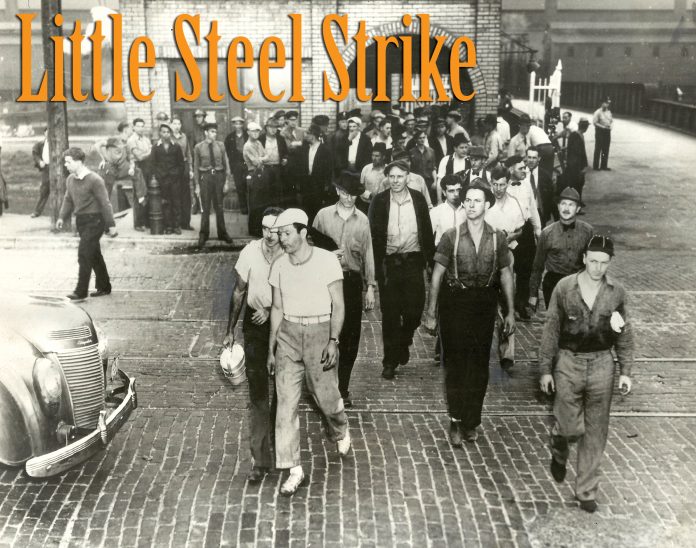
Gunfire rang out. Strikers and sympathizers fell to the ground. Two people died at an entrance of the Republic Steel mill on Poland Avenue in Youngstown, and many were wounded.
These developments in the history of relations between American labor and management took place 80 years ago today on ground that was laden with iron ore that, poured into iron and cast into steel, shaped the United States into a robust industrial nation.
And, around the world, conditions were developing that, in just a few years, would lead to the Second World War – a conflict that would rely on the iron ore that would come from the Great Lakes region.
By all accounts, Big Steel consisted of the United States Steel Corp., and by some accounts, Jones & Laughlin Steel Corp. The Little Steel manufacturers were so-named because they were smaller in output than Big Steel, but were still major, independent steel companies. Locally Little Steel included Republic Steel and Youngstown Sheet & Tube.
After Big Steel signed a labor agreement with the Steel Workers Organizing Committee (the predecessor of the United States Steelworkers) in March 1937, SWOC set it sights on Little Steel. The smaller companies were adamant in their refusal to sign contracts with SWOC and decided to endure strikes instead – even if the work stoppages proved deadly. Here, two died and 42 were injured in violence on June 21, 1937, at the main entrance to Republic Steel’s Poland Avenue Plant in Youngstown.
In 2015, Andy Verhoff, representing the Ohio History Connection, and Bill Lawson of the Mahoning Valley Historical Society, unveiled a series of historical markers on Central Square. A plaque commemorating the Little Steel Strike of 1937 was among those unveiled. It stands on the northeast section of Central Square in front of the Stambaugh Building, the former headquarters of Youngstown Sheet and Tube. (Metro Monthly file image)Turmoil in the 30s – The story of the Little Steel Strike of 1937 is a story of management and labor that embroiled the Mahoning Valley in tension and violence, but that eventually improved the lives of workers and their families, firmly carving out a role for unions in American life. The American steel worker became one of the best-paid laborers in the world, as steel remained king throughout most of the 20th century.
“The most significant, direct result of the strike was the transformation of the labor movement in not only the steel industry, but all heavy industries, from basically local and ineffective organizations into all-encompassing, nationwide collective bargaining representatives of American workers,” wrote William Lawson, historian and executive director of the Mahoning Valley Historical Society, in an academic analysis written in 1987. Besides wages and benefits, labor contracts gave American steel workers previously unheard of safety standards in the workplace.
In Youngstown, the Little Steel Strike is memorialized on Public Square with a historical marker. The marker recalls a time that workers took their grievances to the pavement and shed blood to fight for a fair deal.
Indeed, Congressional hearings revealed that the Little Steel companies had stockpiles of weapons they were prepared to use against strikers. Youngstown Sheet & Tube Co. officials testified that its arsenal contained $10,000 worth of tear gas, eight machine guns, 452 revolvers, 314 pistols and 190 shotguns, The Vindicator reported in an Associated Press story. Backed with such firepower and the will to use it, Little Steel management stood its ground.
Tom Mercer Girdler, the president, chairman, and chief executive officer of Republic Steel, gestures during his testimony before the U.S. Senate Committee on the Post Office on June 24, 1937. Mercer was testifying about Republic Steel’s actions during the Little Steel strike of spring 1937. (From the Harris & Ewing Collection at the Library of Congress) A meeting of legal advisors in the ‘Republic Steel’ unfair labor practices case in Washington, D.C., in July 1937. From left to right: Unidentified man; Edwin S. Smith, member, National Labor Relations Board; Stanley Switter, Chief of Police, Massillon, Ohio; Luther Day, attorney for Republic Steel; unidentified man. The National Labor Relations Board charged Republic Steel with violations of the National Labor Relations Act after the ‘Little Steel strike’ of spring 1937. During the strike, several people died at the Massillon works. (From the Harris & Ewing Collection at the Library of Congress)Background – The movement toward unionization of the steel industry was begat in blood in the late 1800s, when the Amalgamated Association of Iron, Steel and Tin Workers was locked out of the Carnegie Co. Plant at Homestead, Pa. The immediate issue was the intention of Andrew Carnegie to cut employee wages. On July 6, 1892, a riot over the scheduled reopening of the plant with non-union labor left 10 people dead and dozens injured.
On January 7, 1916, in East Youngstown, current-day Campbell, guards at Youngstown Sheet & Tube’s mill opened fire on a crowd of striking steelworkers, killing three and injuring 125. The crowd rioted and burned six blocks of the business district. The next day, 2,000 National Guard troops arrived to restore order.
Later steel strikes were fought in the halls of law more than on the streets. For example, in 1952, in the case of Youngstown Sheet & Tube vs. Sawyer, President Harry S. Truman ordered seizure of the nation’s steel mills. His purpose was to fend off a strike he claimed would harm the U.S. during the Korean War. The steel companies sued the president on behalf of Congress saying that the presidential action had violated the constitutional doctrine of the separation of powers. Six High Court Justices agreed.
In 1959, in a case that many believe led to the first significant import of foreign steel, the United Steel Workers struck over management’s ability to modify work rules. In a 116-day strike, the USW kept the contract language and achieved minimal wage increases. Many believe that this strike began the devastation of the American steel industry.
Editor’s note: Marie Shellock wrote this history of the Little Steel Strike for Metro Monthly in 2007. It was subsequently published in “Remembering Youngstown: Tales from the Mahoning Valley” (The History Press) in 2009. The Little Steel Strike began 80 years ago on May 26, 1937.
***
Metro Monthly is a local news and events magazine based in Youngstown, Ohio. We circulate throughout the Mahoning Valley and offer print and online editions. Be sure to visit our publication’s website for news, features and community events. Office: 330-259-0435.




